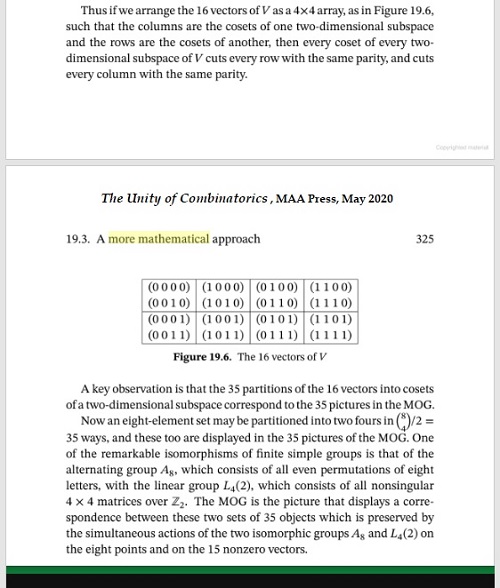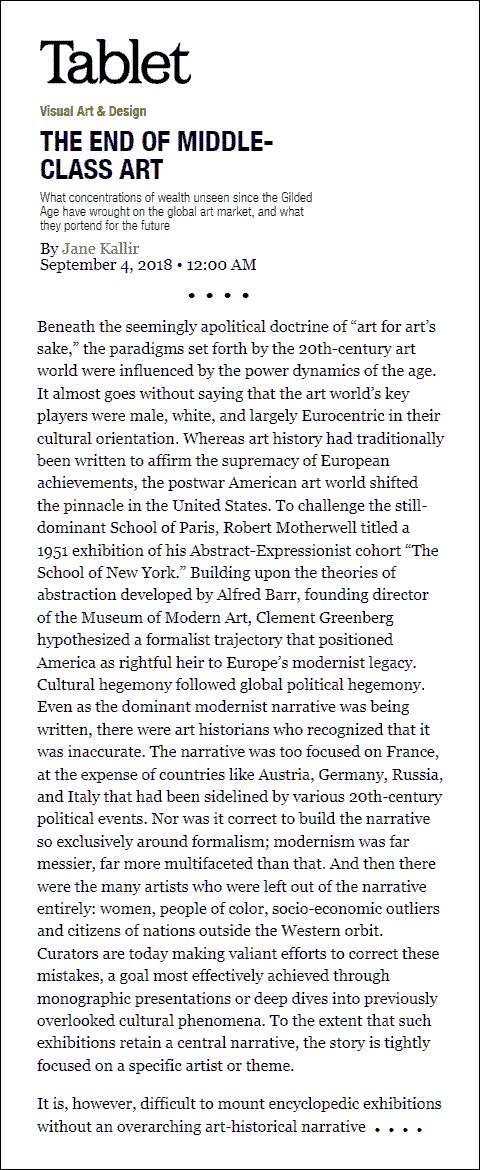Thursday, May 8, 2025
From a post of April 17, 2025 —

Some may interpret this as a chessboard, with the white bishops on
their home squares 39 and 36 and the black bishops on 33 and 30.
"I like to fold my magic carpet, after use,
in such a way as to superimpose
one part of the pattern upon another."
– Vladimir Nabokov in Speak, Memory
Thursday, March 27, 2025
Comments Off on A Tale for Holland, Michigan:
Red Sails in the Sunset
Thursday, August 29, 2024
Peter Woit this afternoon on "The Terrifying Power of Mathematics" —
"… the quantum field theory of fields satisfying the Dirac equation.
Here there’s a standard apparatus of how to calculate given in
every quantum field theory textbook. These standard calculations
involving Dirac gamma-matrices fit well with Feynman’s 'physicists
finding they have the correct equations without understanding them
have been so terrified they give up trying to understand them'."
For a definition of these matrices, see . . .
Weisstein, Eric W. "Dirac Matrices."
From MathWorld — A Wolfram Web Resource.
https://mathworld.wolfram.com/DiracMatrices.html —
"The Dirac matrices are a class of 4×4 matrices which arise
in quantum electrodynamics. There are a variety of different
symbols used, and Dirac matrices are also known as
gamma matrices or Dirac gamma matrices."
For related religious remarks, see "Physics for Poets"
( Log24, April 20, 2022 ).
Comments Off on Fearful Symmetry
Wednesday, August 21, 2024

Related reading . . . Other posts now tagged "Original Conspiracy."
Comments Off on “Triangle of Sadness” Conspiracy?
Wednesday, August 14, 2024

"Before time began . . . ." — Optimus Prime
Comments Off on Midnight Not in Paris
Thursday, April 25, 2024

As for time … See this journal on the above Sting date.
A professional hallucinator that
some will find more entertaining:

Comments Off on Time and Chance
Wednesday, April 24, 2024
Poetry critic Helen Vendler reportedly died yesterday at 90.


Comments Off on Plan 9 for Helen Vendler
Tuesday, June 13, 2023

"Does the expression 'generative pre-trained transformer'
mean anything to you?"
Comments Off on Inquisitive Minds Want to Know
Sunday, March 5, 2023
Comments Off on Geometry and Death Continued* —
The Case of Richard Brautigan
Wednesday, August 17, 2022
"And, as with all retold tales that are in people's hearts,
there are only good and bad things and black and white
things and good and evil things and no in-between anywhere."
— John Steinbeck, author's epigraph to The Pearl
From the Season 4 finale of Westworld :
uploading Dolores's pearl at Hoover Dam —

For those who prefer greater theological simplicity . . .
Optimus Prime on a different Hoover Dam figure, that of
the AllSpark: "Before time began, there was the Cube."
Simplifying even more . . .
“A set having three members is a single thing
wholly constituted by its members but distinct from them.
After this, the theological doctrine of the Trinity as
‘three in one’ should be child’s play.”
– Max Black, Caveats and Critiques: Philosophical Essays
in Language, Logic, and Art , Cornell U. Press, 1975

As above, Black's theology forms a cube.
Comments Off on Cold Comfort Dam
Thursday, July 14, 2022

Also on April 1, 2015 —
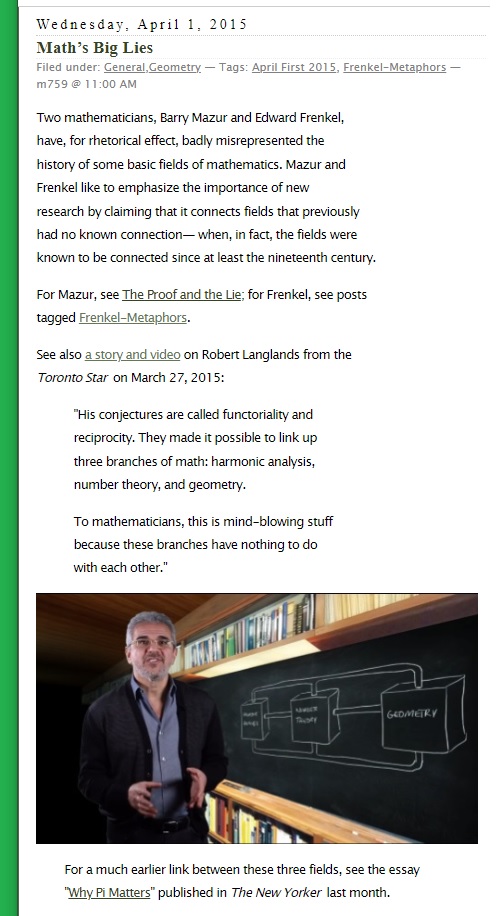
From the essay cited above —

For the formula of building blocks , see Walsh series.
* See Google.
Comments Off on For Dark Jokester*
Wednesday, July 13, 2022
Comments Off on Annals of Comparative Linguistics
A New Yorker writer on why he wanted to
learn mathematics at an advanced age —
|
"The challenge, of course, especially in light of the collapsing horizon, since I was sixty-five when I started. Also, I wanted especially to study calculus because I never had. I didn’t even know what it was—I quit math after feeling that with Algebra II I had pressed my luck as far as I dared. Moreover, I wanted to study calculus because Amie told me that when she was a girl William Maxwell had asked her what she was studying, and when she said calculus he said, 'I loved calculus.' Maxwell would have been about the age I am now. He would have recently retired after forty years as an editor of fiction at The New Yorker , where he had handled such writers as Vladimir Nabokov, Eudora Welty, John Cheever, John Updike, Shirley Hazzard, and J. D. Salinger. When Salinger finished Catcher in the Rye , he drove to the Maxwells’ country house and read it to them on their porch. I grew up in a house on the same country road that Maxwell and his wife, Emily, lived on, and Maxwell was my father’s closest friend."
— Wilkinson, Alec. A Divine Language (p. 5). Published
July 12, 2022, by Farrar, Straus and Giroux. Kindle Edition.
|
See as well two versions of
a very short story, "Turning Nine."
Wilkinson's title is of course deplorable.
Related material: "Night Hunt" in a
Log24 search for the phrase "Good Question."
Comments Off on A New Yorker Child’s Progress
Tuesday, July 12, 2022
Previously on Log24:

"Tell it Skewb." — Motto adapted from Emily Dickinson.
On further investigation . . .

From the above Sanfilippo date —

Comments Off on “Tell it Skewb” continues.
"The successful artist shares with the politician
a recurrent temptation to indulge in emotional claptrap.
Bernard Bosanquet in Three Lectures on Aesthetic (1915)
proposed that this urge to chase after tears or laughter
could be quelled by attaching the art-emotion to a particular object
and not a set of reactions. His consequent definition of art was
'feeling expressed for expression’s sake.' Notice, however, that
this is something only the deranged would dream of wanting in
real life. Our everyday expressions of feeling are spontaneous and
practical; they are never 'for expression’s sake.' By contrast,
aesthetic feeling is self-sufficient."
— David Bromwich in The Nation, July 11, 2022
A Particular Object —

"Tell it Skewb." — Motto adapted from Emily Dickinson.
Comments Off on Object Lesson: The Quelling
Monday, July 11, 2022
Wednesday, June 29, 2022
On the Lynx web browser —
"As of 2022, it is the oldest web browser still being maintained,,,,"
"The speed benefits of text-only browsing are most apparent
when using low bandwidth internet connections, or older computer
hardware that may be slow to render image-heavy content."
— Wikipedia [“Older” link added.]
And then there is . . .

See as well the LYNX of Oslo artist Josefine Lyche.
Update of June 30, 2022 —
Lyche, whose art often incorporates mathematical notions,
has not yet, as far as I know, explored the Borromean link
(three rings, linked mutually but not pairwise) in her art.
Remarks by a different math fan, Evelyn Lamb —
"I have had a thing for the Borromean rings for years now.
There’s something so poetic about them. The three rings
are strong together, but they fall apart if any one of them
is removed. Alternatively, the three rings are trapped together
until one of them leaves and sets the others free. I’m kind of
surprised there isn’t a Wisława Szymborska poem or
Tom Stoppard play that explores the metaphorical possibilities
in the Borromean rings." — Scientific American , Sept. 30, 2016.
See also the Lamb date Sept. 30, 2016, as well as work
by Lyche, in Log24 posts tagged Star Cube.
Related material — The Log24 post Borromean Generators.
Comments Off on Techie Wordplay: “Lynx”
Wednesday, February 23, 2022
Comments Off on The Unity of Mathematics
Monday, February 21, 2022

"The class is objectively characterized, but not
the individual coordinate assignment."
Tell it to Watchduck, Hermann.

See a related remark by Quack5quack in Raiders of the Lost Coordinates.
Comments Off on Stimulus
Wednesday, February 16, 2022
Comments Off on Meta Mates
Tuesday, February 15, 2022
"Stories are the only way people can absorb information
in any depth" — Stephen Lussier, retired De Beers executive
Related story — De Beer's Consolidated Mine
“Nothing Lasts Forever” will screen at Berlinale
on February 12th at 9 pm at Cubix 7, February 17th
at 9 pm at Cubix 5 and 6, and February 18th at 6 pm
at Cubix 5 and 6. — https://moveablefest.com

See as well "Story Theory of Truth" in this journal.
Comments Off on “… Then We Take Berlin” — Leonard Cohen
Monday, February 14, 2022
" Welcher Art ist die ursprüngliche Einheit,
daß sie sich in diese Scheidung auseinanderwirft,
und in welchem Sinn sind die Geschiedenen
hier als Wesung der Ab-gründigkeit gerade einig?
Hier kann es sich nicht um irgend eine »Dialektik«
handeln, sondern nur um die Wesung des Grundes
(der Wahrheit also) selbst."
— Heidegger
"Before time began, there was the Cube." — Optimus Prime
Comments Off on Artbusters: Cubism
Saturday, February 12, 2022
Thomas Mann on "the mystery of the unity" —

"Denn um zu wiederholen, was ich anfangs sagte:
in dem Geheimnis der Einheit von Ich und Welt,
Sein und Geschehen, in der Durchschauung des
scheinbar Objectiven und Akzidentellen als
Veranstaltung der Seele glaube ich den innersten Kern
der analytischen Lehre zu erkennen." (GW IX 488)
An Einheit-Geheimnis that is perhaps* more closely related
to pure mathematics** —
"What is the nature of the original unity
that throws itself apart in this separation,
and in what sense are the separated ones
here as the essence of the abyss?
Here it cannot be a question of any kind of 'dialectic,'
but only of the essence of the ground
(that is, of truth) itself." [Tr. by Google]
" Welcher Art ist die ursprüngliche Einheit,
daß sie sich in diese Scheidung auseinanderwirft,
und in welchem Sinn sind die Geschiedenen
hier als Wesung der Ab-gründigkeit gerade einig?
Hier kann es sich nicht um irgend eine »Dialektik«
handeln, sondern nur um die Wesung des Grundes
(der Wahrheit also) selbst."
— Heidegger
* Or perhaps not .
** For a relevant Scheidung , see Eightfold Cube.
Comments Off on Das Geheimnis der Einheit
Friday, February 11, 2022

The misleading image at right above is from the cover of
an edition of Charles Williams's classic 1931 novel
Many Dimensions published in 1993 by Wm. B. Eerdmans.
But seriously . . .


Comments Off on De Beer’s Consolidated Mine
Thursday, February 10, 2022
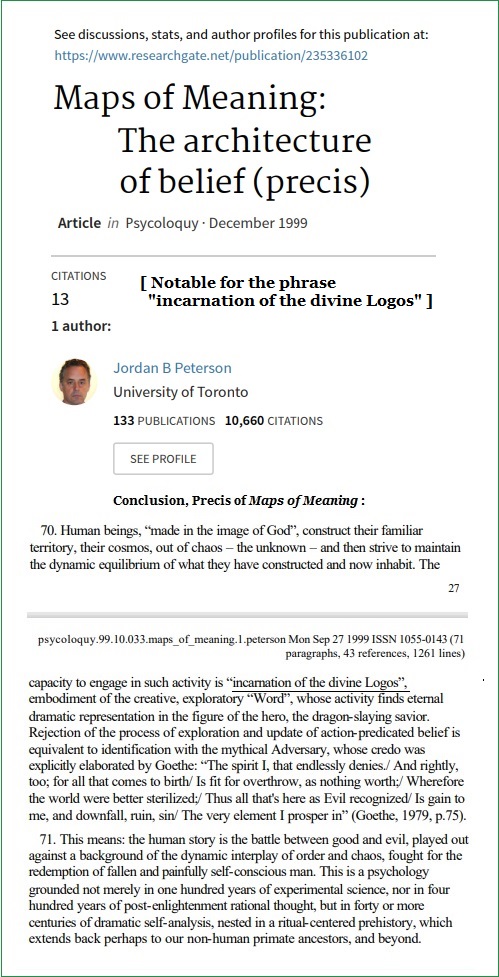

Related illustration from a search in this journal for Wechsler —
Above: Dr. Harrison Pope, Harvard professor of psychiatry,
demonstrates the use of the Wechsler Adult Intelligence Scale (WAIS)
“block design” subtest.
— From a Log24 search for “Harrison Pope.”
Comments Off on Block Design Subtest:
Psycoloquy Meets Psycho Loki
Saturday, February 5, 2022
Shown below is an illustration from "The Puzzle Layout Problem" —

Exercise: Using the above numerals 1 through 24
(with 23 as 0 and 24 as ∞) to represent the points
∞, 0, 1, 2, 3 … 22 of the projective line over GF(23),
reposition the labels 1 through 24 in the above illustration
so that they appropriately* illustrate the cube-parts discussed
by Iain Aitchison in his March 2018 Hiroshima slides on
cube-part permutations by the Mathieu group M24.

A note for Northrop Frye —
Interpenetration in the eightfold cube — the three midplanes —

A deeper example of interpenetration:
Aitchison has shown that the Mathieu group M24 has a natural
action on the 24 center points of the subsquares on the eightfold
cube's six faces (four such points on each of the six faces). Thus
the 759 octads of the Steiner system S(5, 8, 24) interpenetrate
on the surface of the cube.
* "Appropriately" — I.e. , so that the Aitchison cube octads correspond
exactly, via the projective-point labels, to the Curtis MOG octads.
Comments Off on Mathieu Cube Labeling
Saturday, March 13, 2021
According to Lt. Col. Wayne M. McDonnell in June 1983 —
“… it is accurate to observe that when a person experiences
the out-of- body state he is, in fact, projecting that eternal spark
of consciousness and memory which constitutes the ultimate
source of his identity….”
— Section 27, “Consciousness in Perspective,” of
“Analysis and Assessment of Gateway Process.”
A related quotation —
“In truth, the physical AllSpark is but a shell….”
— https://tfwiki.net/wiki/AllSpark
From the post Ghost in the Shell (Feb. 26, 2019) —

See also, from posts tagged Ogdoad Space —
“Like the Valentinian Ogdoad— a self-creating theogonic system
of eight Aeons in four begetting pairs— the projected eightfold work
had an esoteric, gnostic quality; much of Frye’s formal interest lay in
the ‘schematosis’ and fearful symmetries of his own presentations.”
— From p. 61 of James C. Nohrnberg’s “The Master of the Myth
of Literature: An Interpenetrative Ogdoad for Northrop Frye,”
Comparative Literature , Vol. 53 No. 1, pp. 58-82, Duke University
Press (quarterly, January 2001)
— as well as . . .

Related illustration from posts tagged with
the quilt term Yankee Puzzle —

Comments Off on Eternal Spark
Wednesday, August 26, 2020
Comments Off on The Book of Ezra
Wednesday, July 22, 2020
“The pattern of the thing precedes the thing.
I fill in the gaps of the crossword at any spot
I happen to choose. These bits I write on
index cards until the novel is done.”
— Vladimir Nabokov, interview,
Paris Review No. 41 (Summer-Fall 1967).

Another story —


Related material: Mathematics as a Black Art.
Comments Off on Card
Thursday, July 2, 2020
[Update of Sunday morning, July 12, 2020 —
This July 2 post was suggested in part by the July 1 post Magic Child
and in part by the Sept. 15, 1984, date in the image below. For more
details about that date, possibly the death date of author Richard
Brautigan, see "The Life and Death of Richard Brautigan," by
Lawrence Wright, in Rolling Stone on April 11, 1985.
From that article:
Marcia called him the next night [Sept. 15, 1984]
in Bolinas. He asked if she liked his mind. "I said,
‘Yes, Richard, I like your mind. You have the ability
to jump in and out of spaces. It’s not linear thinking;
it’s exciting, catalytic, random thinking.’ "
Such thinking, though interesting, is not recommended for the
general public. Sept. 15, 1984, was perhaps Brautigan's last day alive.]

* See Maxwell in posts tagged Gods and Giants.
Comments Off on The Maxwell* Enticement
Saturday, May 23, 2020
"MIT professor of linguistics Wayne O’Neil died on March 22
at his home in Somerville, Massachusetts."
— MIT Linguistics, May 1, 2020

The "deep structure" above is the plane cutting the cube in a hexagon
(as in my note Diamonds and Whirls of September 1984).
See also . . .

Comments Off on Structure for Linguists
Sunday, May 17, 2020
"Let me say this about that." — Richard Nixon
Interpenetration in Weyl's epistemology —

Interpenetration in Mazzola's music theory —

Interpenetration in the eightfold cube — the three midplanes —

A deeper example of interpenetration:
Aitchison has shown that the Mathieu group M24 has a natural
action on the 24 center points of the subsquares on the eightfold
cube's six faces (four such points on each of the six faces). Thus
the 759 octads of the Steiner system S(5, 8, 24) interpenetrate
on the surface of the cube.
Comments Off on “The Ultimate Epistemological Fact”
Source citation for an article quoted here last night —
“Hegel’s Conceptual Group Action” —

A check of that source yields the seal of the University of Torino —

Related material —

Comments Off on Gran Torino
Saturday, May 16, 2020
Comments Off on Bullshit Studies
Thursday, May 7, 2020
“Mathematics may be art, but to the general public it is
a black art, more akin to magic and mystery. This presents
a constant challenge to the mathematical community: to explain
how art fits into our subject and what we mean by beauty.”
— Sir Michael Atiyah, quoted here on April 4, 2016


Illustrations, from the American Mathematical Society Spring
2020 book sale, of a book scheduled to be published May 28.
Comments Off on Now You See It, Now You Don’t
Sunday, April 19, 2020
A language game on Orthodox Easter —
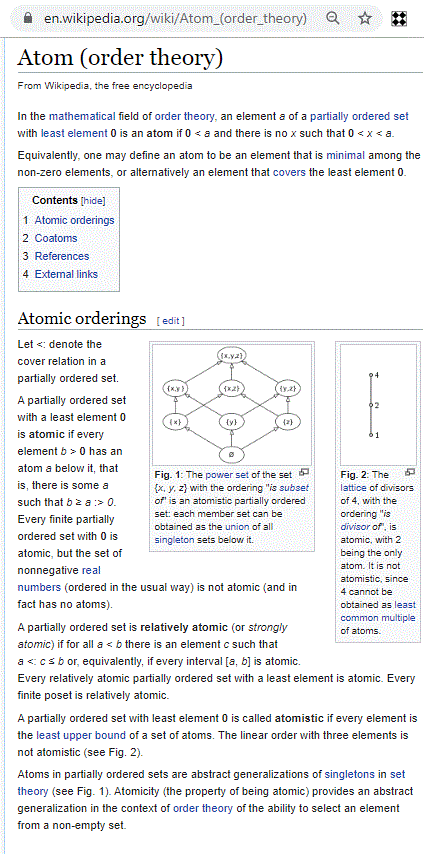
See also Geometric Theology and Trinity Staircase.
Comments Off on Easter Egg for Wittgenstein
Tuesday, March 17, 2020
“Before time began…” — Optimus Prime

See also posts tagged Aitchison.
Comments Off on Geometric Theology
Sunday, March 1, 2020
Freeman Dyson on his staircase at Trinity College
(University of Cambridge) and on Ludwig Wittgenstein:
“I held him in the highest respect and was delighted
to find him living in a room above mine on the same
staircase. I frequently met him walking up or down
the stairs, but I was too shy to start a conversation.”
Frank Close on Ron Shaw:
“Shaw arrived there in 1949 and moved into room K9,
overlooking Jesus Lane. There is nothing particularly
special about this room other than the coincidence that
its previous occupant was Freeman Dyson.”
— Close, Frank. The Infinity Puzzle (p. 78).
Basic Books. Kindle Edition.
See also other posts now tagged Trinity Staircase.
Illuminati enthusiasts may enjoy the following image:

Comments Off on Same Staircase, Different Day
Monday, December 2, 2019

"What the piece of art is about is the gray space in the middle."
— David Bowie, as quoted in the above Crimson piece.
Bowie's "gray space" is the space between the art and the beholder.
I prefer the gray space in the following figure —

Context: The Trinity Stone (Log24, June 4, 2018).
Comments Off on Aesthetics at Harvard
Sunday, December 1, 2019

From this journal on the above date — April 13, 2014 (Gray Space) —
Review of Seeing Gray , a book by pastor Adam Hamilton
of the United Methodist Church of the Resurrection
in Leawood, Kansas, a suburb of Kansas City—
“Adam Hamilton invites us to soulful gray space
between polarities, glorious gray space that is holy,
mysterious, complex, and true. Let us find within
our spirits the courage and humility to live and learn
in this faithful space, to see gray, to discern a more
excellent way.”
—Review by United Methodist Bishop Hope Morgan Ward
The above flashback was suggested by CBS Sunday Morning today —

See also Romanesque in this journal.

Comments Off on Space Song
Sunday, September 29, 2019
The previous post dealt with "magic" cubes, so called because of the
analogous "magic" squares. Douglas Hofstadter has written about a
different, physical , object, promoted as "the Magic Cube," that Hofstadter
felt embodied "a deep invariant":

Comments Off on Stage Direction: “Comments Off.”
Wednesday, August 21, 2019
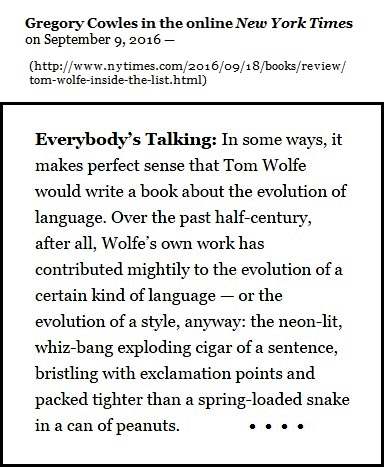
Continued (from previous post) . . .


Comments Off on Spring-Loaded
Sunday, June 2, 2019
A remark on coordinatization linked to by John Baez today —

This suggests a more historical perspective:

See as well a search for Interpenetration in this journal.
Comments Off on Interpenetration
Wednesday, May 1, 2019
"The purpose of mathematics cannot be derived from an activity
inferior to it but from a higher sphere of human activity, namely,
religion."
— Igor Shafarevitch in 1973



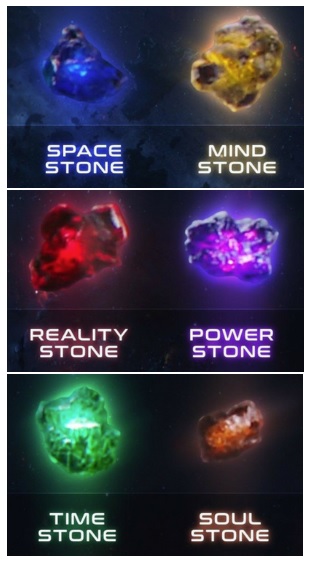
"The hint half guessed, the gift half understood, is Incarnation."
— T. S. Eliot in Four Quartets

See also Ultron Cube.
Comments Off on For the First of May
Friday, March 22, 2019
"The stars and galaxies seem static, eternal, or moving slowly
in deterministic patterns, becoming the background stage
on which we move. But if we could speed up the sequence,
we would see how dramatic and unpredictable this background
really is — an actor, director, script and stage all at once.
Moreover, it is a unified universe, a single unfolding event
of which we are an embedded part, a narrative of highly
dangerous and fine-tuned events, something more like
a detective thriller with many crimes and last-minute escapes
than the impersonal account of astronomy textbooks.
We are only just beginning to decipher the plot and figure out
the Cosmic Code, as Heinz Pagels puts it."
— Charles Jencks, The Architecture of the Jumping Universe :
A Polemic (How Complexity Science is Changing Architecture
and Culture), Academy Editions, 1995, rev. ed. 1997
"A Grand Unified Theory (GUT) is a model in particle physics…."
— Wikipedia
"Under the GUT symmetry operation these field components
transform into one another. The reason quantum particles
appear to have different properties in nature is that the unifying
symmetry is broken. The various gluons, quarks and leptons
are analogous to the facets of a cut diamond, which appear
differently according to the way the diamond is held but in
fact are all manifestations of the same underlying object."
— Heinz Pagels, Perfect Symmetry , Bantam paperback, 1986, p. 284
See also the recent post Multifaceted Narrative.
Comments Off on Charles Jencks’s Grand Unified Theory
Wednesday, December 12, 2018
Those pleased by what Ross Douthat today called
"The Return of Paganism" are free to devise rituals
involving what might be called "the sacred geometry
of the Kummer 166 configuration."
As noted previously in this journal,
"The hint half guessed, the gift half understood, is Incarnation."
— T. S. Eliot in Four Quartets

See also earlier posts also tagged "Kummerhenge" and
another property of the remarkable Kummer 166 —

For some related literary remarks, see "Transposed" in this journal.
Some background from 2001 —

Comments Off on Kummerhenge Continues.
Friday, December 7, 2018
(Continued from this morning)


"The hint half guessed, the gift half understood, is Incarnation."
— T. S. Eliot in Four Quartets

See also other Log24 posts tagged Kummerhenge.

Comments Off on The Angel Particle
Sunday, December 2, 2018
A search this morning for articles mentioning the Miracle Octad Generator
of R. T. Curtis within the last year yielded an abstract for two talks given
at Hiroshima on March 8 and 9, 2018 —
http://www.math.sci.hiroshima-u.ac.jp/
branched/files/2018/abstract/Aitchison.txt
Iain AITCHISON
Title:
Construction of highly symmetric Riemann surfaces, related manifolds, and some exceptional objects, I, II
Abstract:
Since antiquity, some mathematical objects have played a special role, underpinning new mathematics as understanding deepened. Perhaps archetypal are the Platonic polyhedra, subsequently related to Platonic idealism, and the contentious notion of existence of mathematical reality independent of human consciousness.
Exceptional or unique objects are often associated with symmetry – manifest or hidden. In topology and geometry, we have natural base points for the moduli spaces of closed genus 2 and 3 surfaces (arising from the 2-fold branched cover of the sphere over the 6 vertices of the octahedron, and Klein's quartic curve, respectively), and Bring's genus 4 curve arises in Klein's description of the solution of polynomial equations of degree greater than 4, as well as in the construction of the Horrocks-Mumford bundle. Poincare's homology 3-sphere, and Kummer's surface in real dimension 4 also play special roles.
In other areas: we have the exceptional Lie algebras such as E8; the sporadic finite simple groups; the division algebras: Golay's binary and ternary codes; the Steiner triple systems S(5,6,12) and S(5,8,24); the Leech lattice; the outer automorphisms of the symmetric group S6; the triality map in dimension 8; and so on. We also note such as: the 27 lines on a cubic, the 28 bitangents of a quartic curve, the 120 tritangents of a sextic curve, and so on, related to Galois' exceptional finite groups PSL2(p) (for p= 5,7,11), and various other so-called `Arnol'd Trinities'.
Motivated originally by the `Eightfold Way' sculpture at MSRI in Berkeley, we discuss inter-relationships between a selection of these objects, illustrating connections arising via highly symmetric Riemann surface patterns. These are constructed starting with a labeled polygon and an involution on its label set.
Necessarily, in two lectures, we will neither delve deeply into, nor describe in full, contexts within which exceptional objects arise. We will, however, give sufficient definition and detail to illustrate essential inter-connectedness of those exceptional objects considered.
Our starting point will be simplistic, arising from ancient Greek ideas underlying atomism, and Plato's concepts of space. There will be some overlap with a previous talk on this material, but we will illustrate with some different examples, and from a different philosophical perspective.
Some new results arising from this work will also be given, such as an alternative graphic-illustrated MOG (Miracle Octad Generator) for the Steiner system S(5,8,24), and an alternative to Singerman – Jones' genus 70 Riemann surface previously proposed as a completion of an Arnol'd Trinity. Our alternative candidate also completes a Trinity whose two other elements are Thurston's highly symmetric 6- and 8-component links, the latter related by Thurston to Klein's quartic curve.
|
See also yesterday morning's post, "Character."
Update: For a followup, see the next Log24 post.
Comments Off on Symmetry at Hiroshima
Thursday, November 22, 2018
"The hint half guessed, the gift half understood, is Incarnation."
— T. S. Eliot in Four Quartets

Note also the four 4×4 arrays surrounding the central diamond
in the chi of the chi-rho page of the Book of Kells —

From a Log24 post
of March 17, 2012
"Interlocking, interlacing, interweaving"
— Condensed version of page 141 in Eddington's
1939 Philosophy of Physical Science
Comments Off on Geometric Incarnation
Thursday, November 8, 2018
From https://blogs.scientificamerican.com/…
|
A Few of My Favorite Spaces:
The Fano Plane
The intuition-challenging Fano plane may be
the smallest interesting configuration
of points and lines.
By Evelyn Lamb on October 24, 2015
"…finite projective planes seem like
a triumph of purely axiomatic thinking
over any hint of reality. . . ."
|
For Fano's axiomatic approach, see the Nov. 3 Log24 post
"Foundations of Geometry."
For the Fano plane's basis in reality , see the eightfold cube
at finitegeometry.org/sc/ and in this journal.
See as well "Two Views of Finite Space" (in this journal on the date
of Lamb's remarks — Oct. 24, 2015).
Some context: Gödel's Platonic realism vs. Hilbert's axiomatics
in remarks by Manuel Alfonseca on June 7, 2018. (See too remarks
in this journal on that date, in posts tagged "Road to Hell.")
Comments Off on Reality vs. Axiomatic Thinking
Tuesday, September 25, 2018
See some posts related to three names
associated with Trinity College, Cambridge —
Atiyah + Shaw + Eddington .
Comments Off on Trinity
Tuesday, September 11, 2018
Comments Off on Art-Historical Narrative
Monday, August 6, 2018

|
“All right, Jessshica. It’s time to open the boxsssschhh.”
“Gahh,” she said. She began to walk toward the box, but her heart failed her and she retreated back to the chair. “Fuck. Fuck.” Something mechanical purred. The seam she had found cracked open and the top of the box began to rise. She squeezed shut her eyes and groped her way into a corner, curling up against the concrete and plugging her ears with her fingers. That song she’d heard the busker playing on the train platform with Eliot, “Lucy in the Sky with Diamonds”; she used to sing that. Back in San Francisco, before she learned card tricks. It was how she’d met Benny: He played guitar. Lucy was the best earner, Benny said, so that was mainly what she sang. She must have sung it five times an hour, day after day. At first she liked it but then it was like an infection, and there was nothing she could do and nowhere she could go without it running across her brain or humming on her lips, and God knew she tried; she was smashing herself with sex and drugs but the song began to find its way even there. One day, Benny played the opening chord and she just couldn’t do it. She could not sing that fucking song. Not again. She broke down, because she was only fifteen, and Benny took her behind the mall and told her it would be okay. But she had to sing. It was the biggest earner. She kind of lost it and then so did Benny and that was the first time he hit her. She ran away for a while. But she came back to him, because she had nothing else, and it seemed okay. It seemed like they had a truce: She would not complain about her bruised face and he would not ask her to sing “Lucy.” She had been all right with this. She had thought that was a pretty good deal.
Now there was something coming out of a box, and she reached for the most virulent meme she knew. “Lucy in the sky!” she sang. “With diamonds!”
• • •
Barry, Max. Lexicon: A Novel (pp. 247-248).
Penguin Publishing Group. Kindle Edition.
|
Related material from Log24 on All Hallows' Eve 2013 —
Comments Off on The Girl with Kaleidoscope Eyes
Sunday, July 22, 2018
Thursday, June 28, 2018
Comments Off on Trinity Meditation
Wednesday, June 27, 2018
A passage that may or may not have influenced Madeleine L'Engle's
writings about the tesseract :
|
From Mere Christianity , by C. S. Lewis (1952) —
"Book IV – Beyond Personality:
or First Steps in the Doctrine of the Trinity"
. . . .
I warned you that Theology is practical. The whole purpose for which we exist is to be thus taken into the life of God. Wrong ideas about what that life is, will make it harder. And now, for a few minutes, I must ask you to follow rather carefully.
You know that in space you can move in three ways—to left or right, backwards or forwards, up or down. Every direction is either one of these three or a compromise between them. They are called the three Dimensions. Now notice this. If you are using only one dimension, you could draw only a straight line. If you are using two, you could draw a figure: say, a square. And a square is made up of four straight lines. Now a step further. If you have three dimensions, you can then build what we call a solid body, say, a cube—a thing like a dice or a lump of sugar. And a cube is made up of six squares.
Do you see the point? A world of one dimension would be a straight line. In a two-dimensional world, you still get straight lines, but many lines make one figure. In a three-dimensional world, you still get figures but many figures make one solid body. In other words, as you advance to more real and more complicated levels, you do not leave behind you the things you found on the simpler levels: you still have them, but combined in new ways—in ways you could not imagine if you knew only the simpler levels.
Now the Christian account of God involves just the same principle. The human level is a simple and rather empty level. On the human level one person is one being, and any two persons are two separate beings—just as, in two dimensions (say on a flat sheet of paper) one square is one figure, and any two squares are two separate figures. On the Divine level you still find personalities; but up there you find them combined in new ways which we, who do not live on that level, cannot imagine.
In God's dimension, so to speak, you find a being who is three Persons while remaining one Being, just as a cube is six squares while remaining one cube. Of course we cannot fully conceive a Being like that: just as, if we were so made that we perceived only two dimensions in space we could never properly imagine a cube. But we can get a sort of faint notion of it. And when we do, we are then, for the first time in our lives, getting some positive idea, however faint, of something super-personal—something more than a person. It is something we could never have guessed, and yet, once we have been told, one almost feels one ought to have been able to guess it because it fits in so well with all the things we know already.
You may ask, "If we cannot imagine a three-personal Being, what is the good of talking about Him?" Well, there isn't any good talking about Him. The thing that matters is being actually drawn into that three-personal life, and that may begin any time —tonight, if you like.
. . . .
|
But beware of being drawn into the personal life of the Happy Family .
https://www.jstor.org/stable/24966339 —

"The colorful story of this undertaking begins with a bang."
And ends with …
Martin Gardner on Galois—
"Galois was a thoroughly obnoxious nerd,
suffering from what today would be called
a 'personality disorder.' His anger was
paranoid and unremitting."
Comments Off on Taken In
Saturday, June 16, 2018
"The hint half guessed, the gift half understood, is Incarnation."
— T. S. Eliot in Four Quartets
See too "The Ruler of Reality" in this journal.
Related material —

A more esoteric artifact: The Kummer 166 Configuration . . .

An array of Göpel tetrads appears in the background below.

"As you can see, we've had our eye on you
for some time now, Mr. Anderson."
Comments Off on Kummer’s (16, 6) (on 6/16)
Thursday, June 7, 2018

See also David Brooks on logic in today’s online New York Times —
“…the necessary skill of public life, the ability to
see two contradictory truths at the same time.”
Comments Off on Paved with Good Intentions


See also Eightfold Trinity in this journal.

Comments Off on For Dan Brown
Monday, June 4, 2018
“Unsheathe your dagger definitions.” — James Joyce, Ulysses
The “triple cross” link in the previous post referenced the eightfold cube
as a structure that might be called the trinity stone .



Comments Off on The Trinity Stone Defined
Thursday, May 17, 2018

Quoted here on May 5, 2018 —

|
" Lying at the axis of everything, zero is both real and imaginary. Lovelace was fascinated by zero; as was Gottfried Leibniz, for whom, like mathematics itself, it had a spiritual dimension. It was this that let him to imagine the binary numbers that now lie at the heart of computers: 'the creation of all things out of nothing through God's omnipotence, it might be said that nothing is a better analogy to, or even demonstration of such creation than the origin of numbers as here represented, using only unity and zero or nothing.' He also wrote, 'The imaginary number is a fine and wonderful recourse of the divine spirit, almost an amphibian between being and nonbeing.' "
— A footnote from page 229 of Sydney Padua's
April 21, 2015, book on Lovelace and Babbage
|
The page number 229 may also be interpreted, cabalistically,
as the date 2/29, Leap Day.
See Leap Day 2016 among the posts tagged Mind Spider.
Comments Off on Leap
Thursday, March 29, 2018
From the Diamond Theorem Facebook page —

A question three hours ago at that page —
"Is this Time Cube?"
Notes toward an answer —


And from Six-Set Geometry in this journal . . .

Comments Off on “Before Creation Itself . . .”
Saturday, February 17, 2018
Michael Atiyah on the late Ron Shaw —

Phrases by Atiyah related to the importance in mathematics
of the two-element Galois field GF(2) —
- “The digital revolution based on the 2 symbols (0,1)”
- “The algebra of George Boole”
- “Binary codes”
- “Dirac’s spinors, with their up/down dichotomy”
These phrases are from the year-end review of Trinity College,
Cambridge, Trinity Annual Record 2017 .
I prefer other, purely geometric, reasons for the importance of GF(2) —
- The 2×2 square
- The 2x2x2 cube
- The 4×4 square
- The 4x4x4 cube
See Finite Geometry of the Square and Cube.
See also today’s earlier post God’s Dice and Atiyah on the theology of
(Boolean) algebra vs. (Galois) geometry:

Comments Off on The Binary Revolution
Thursday, November 30, 2017
Scholia on the title — See Quantum + Mystic in this journal.

The Matrix of Lévi-Strauss —

"In Vol. I of Structural Anthropology , p. 209, I have shown that
this analysis alone can account for the double aspect of time
representation in all mythical systems: the narrative is both
'in time' (it consists of a succession of events) and 'beyond'
(its value is permanent)." — Claude Lévi-Strauss, 1976
I prefer the earlier, better-known, remarks on time by T. S. Eliot
in Four Quartets , and the following four quartets (from
The Matrix Meets the Grid) —
 .
.
From a Log24 post of June 26-27, 2017:
A work of Eddington cited in 1974 by von Franz —

See also Dirac and Geometry and Kummer in this journal.
Ron Shaw on Eddington's triads "associated in conjugate pairs" —

For more about hyperbolic and isotropic lines in PG(3,2),
see posts tagged Diamond Theorem Correlation.

For Shaw, in memoriam — See Contrapuntal Interweaving and The Fugue.
Comments Off on The Matrix for Quantum Mystics
Sunday, November 5, 2017
A model of the smallest projective line:

Related drama: See Wicker Man in this journal.
Comments Off on Trinity
Thursday, August 3, 2017
Or: Trinity Test Site

From the New York Times Book Review of
next Sunday, August 6, 2017 —
"In a more conventional narrative sequence,
even a sequence of poems,
this interpenetration would acquire
sequence and evolution." [Link added.]
The concept under review is that of the Holy Trinity.
See also, in this journal, Cube Trinity.
For a simpler Trinity model, see the three-point line …

Comments Off on Poetic Theology at the New York Times
Thursday, April 27, 2017
An image in the previous post referred to something called
“universal logic,” touted in 2015 by the publisher Birkhäuser*
as a “new interdisciplinary field.”
From this journal on April 20 last year —
Universal Logic and the Road to Hell.
* See the webpage excerpted below.

Comments Off on Road to Hell
Friday, April 21, 2017
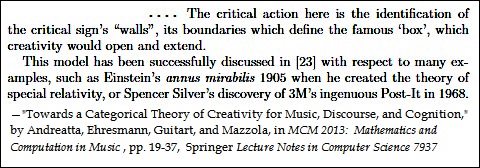
A box from the annus mirabilis —
See Hudson's 4×4 array.
Related material —

Comments Off on Music Box
Wednesday, November 30, 2016
"Frye's largely imaginary eightfold roman
may have provided him a personal substitute—
or alternative— for both ideology and myth."
— P. 63 of James C. Nohrnberg, "The Master of
the Myth of Literature: An Interpenetrative Ogdoad
for Northrop Frye," Comparative Literature Vol. 53,
No. 1 (Winter, 2001), pp. 58-82
See also today's earlier post In Nuce .
Comments Off on Eightfold Roman
|
Excerpts from James C. Nohrnberg, "The Master of the Myth of Literature: An Interpenetrative Ogdoad for Northrop Frye," Comparative Literature Vol. 53, No. 1 (Winter, 2001), pp. 58-82
From page 58 —
"… the posthumously revealed Notebooks. A major project of the latter was his 'Ogdoad': two groups of four books each. '[T]he second group of four […] were considered to be Blakean "emanations" or counterparts of the first four,' like 'the "double mirror" structure of The Great Code and Words with Power : two inter-reflecting parts of four chapters apiece,' Michael Dolzani reports.* "
* P. 22 of Rereading Frye: The Published and Unpublished Works , ed. David Boyd and Imre Salusinszky, Frye Studies [series] (Toronto: University of Toronto Press, 1998). [Abbreviated as RF .]
From page 62 —
"Visionaries like Blake and dramatists like Wagner seem to be working from some larger, mythic blueprint present in nuce from very early on."
From page 63 —
"Frye's hypothetical books and will-to-totality were obviously fruitful; if the beckoning star was illusory, it nonetheless settled on a real birthplace. The sought-for constructs substituted their scaffolding for a backbone-like confidence in pre-given beliefs; possession of the latter is why Tories like Dr. Johnson and T.S. Eliot could do quite nicely without the constructs. Frye's largely imaginary eightfold roman may have provided him a personal substitute— or alternative— for both ideology and myth."
From page 69 —
"For Frye the chief element of imaginative or expressive form is the myth, which functions structurally in literature like geometric shapes in painting."
From page 71 —
"The metaphysical skyhook lifting the artist free from unreflective social commitment is often a latent or manifest archetype that his work renews or reworks."
From page 77 —
"Frye's treatises— so little annotated themselves— are the notes writ large; the notes in the Notebooks are treatises writ small. They interpenetrate. Denham quotes 'the masters of the T'ien-tai school of Mahayana Buddhism' as saying '[t]he whole world is contained in a mustard seed' (RF 158, 160), and Frye quotes Keats: 'Every point of thought is the center of an intellectual world' (Study 159; cf. Great Code 167-68 and AC 61). …. [Frye’s] complex books were all generated out of the monadic obiter dicta . His kingdom 'is like a grain of mustard seed, which a man took, and cast into his garden, and it grew' (Luke 13:18-19)."
|
Comments Off on In Nuce
Monday, November 28, 2016
Or: A Candle for Sunrise
(Continued)

Commentary —

“Looking carefully at Golay’s code is like staring into the sun.”
— Richard Evan Schwartz
Comments Off on Interpenetration
Saturday, November 5, 2016
Wikipedia— "The first Million Mask March occurred in 2013."
A check of the date of that march in this journal yields …



See as well, more generally, "Interpenetration" in this journal.
Comments Off on Interpenetration
Wednesday, September 28, 2016

See also in this journal "desmic," a term related
to the structure of Heidegger's Sternwürfel .
Comments Off on Star Wars
Monday, May 2, 2016
The previous post, on subjective and objective quality,
suggests a review of Pirsig —
“And finally: Phaedrus, following a path
that to his knowledge had never been taken before
in the history of Western thought,
went straight between the horns of
the subjectivity-objectivity dilemma and said
Quality is neither a part of mind, nor is it a part of matter.
It is a third entity which is independent of the two.
He was heard along the corridors
and up and down the stairs of Montana Hall
singing softly to himself, almost under his breath,
‘Holy, holy, holy…blessed Trinity.’ “
See also Guitart in this journal, noting esp. Zen and the Art.
Comments Off on Quality
Wednesday, April 20, 2016
The reference in the previous post to the work of Guitart and
The Road to Universal Logic suggests a fiction involving
the symmetric generation of the simple group of order 168.
See The Diamond Archetype and a fictional account of the road to Hell …

The cover illustration below has been adapted to
replace the flames of PyrE with the eightfold cube.

For related symmetric generation of a much larger group, see Solomon’s Cube.
Comments Off on Symmetric Generation of a Simple Group
Monday, November 23, 2015
Some background for my post of Nov. 20,
"Anticommuting Dirac Matrices as Skew Lines" —

His earlier paper that Bruins refers to, "Line Geometry
and Quantum Mechanics," is available in a free PDF.
For a biography of Bruins translated by Google, click here.
For some additional historical background going back to
Eddington, see Gary W. Gibbons, "The Kummer
Configuration and the Geometry of Majorana Spinors,"
pages 39-52 in Oziewicz et al., eds., Spinors, Twistors,
Clifford Algebras, and Quantum Deformations:
Proceedings of the Second Max Born Symposium held
near Wrocław, Poland, September 1992 . (Springer, 2012,
originally published by Kluwer in 1993.)
For more-recent remarks on quantum geometry, see a
paper by Saniga cited in today's update to my Nov. 20 post.
Comments Off on Dirac and Line Geometry
Thursday, November 5, 2015
“… the A B C of being….” — Wallace Stevens

Scholia —


Compare to my own later note, from March 4, 2010 —

“It seems that Guitart discovered these ‘A, B, C’ generators first,
though he did not display them in their natural setting,
the eightfold cube.” — Borromean Generators (Log24, Oct. 19)
See also Raiders of the Lost Crucible (Halloween 2015)
and “Guitar Solo” from the 2015 CMA Awards on ABC.
Comments Off on ABC Art or: Guitart Solo
Tuesday, October 20, 2015
“Die Philosophie ist ein Kampf gegen die Verhexung
unsres Verstandes durch die Mittel unserer Sprache.”
— Philosophical Investigations (1953), Section 109
An example of Verhexung from the René Guitart article in the previous post —

See also Ein Kampf .
Comments Off on Verhexung
Monday, October 19, 2015
This post continues recent thoughts on the work of René Guitart.
A 2014 article by Guitart gives a great deal of detail on his
approach to symmetric generation of the simple group of order 168 —
“Hexagonal Logic of the Field F8 as a Boolean Logic
with Three Involutive Modalities,” pp. 191-220 in
The Road to Universal Logic:
Festschrift for 50th Birthday of
Jean-Yves Béziau, Volume I,
Editors: Arnold Koslow, Arthur Buchsbaum,
Birkhäuser Studies in Universal Logic, dated 2015
by publisher but Oct. 11, 2014, by Amazon.com.

See also the eightfold cube in this journal.
Comments Off on Symmetric Generation of the Simple Order-168 Group
Saturday, September 5, 2015

See also Weyl + Palermo in this journal —

* The title refers to the previous post, on a current New Yorker cartoon.
Comments Off on For the Machiavelli School*
Wednesday, June 17, 2015
The title of the previous post, "Slow Art," is a phrase
of the late art critic Robert Hughes.
Example from mathematics:
-
Göpel tetrads as subsets of a 4×4 square in the classic
1905 book Kummer's Quartic Surface by R. W. H. T. Hudson.
These subsets were constructed as helpful schematic diagrams,
without any reference to the concept of finite geometry they
were later to embody.
-
Göpel tetrads (not named as such), again as subsets of
a 4×4 square, that form the 15 isotropic projective lines of the
finite projective 3-space PG(3,2) in a note on finite geometry
from 1986 —
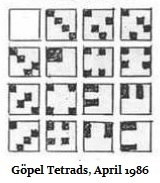
-
Göpel tetrads as these figures of finite geometry in a 1990
foreword to the reissued 1905 book of Hudson:

Click the Barth passage to see it with its surrounding text.
Related material:


Comments Off on Slow Art, Continued
Tuesday, May 19, 2015

"Creation is the birth of something, and
something cannot come from nothing."
— Photographer Peter Lindbergh at his website
From a biography of Lindbergh —
"… it took Lindbergh awhile to find his true métier.
Born in Krefeld, Germany, in 1944….
Barely out of his teens, he became a painter who
embraced conceptual art and — for reasons he
has since forgotten — adopted the professional
name « Sultan. » Lindbergh… was a few years
short of his 30th birthday when he turned to
photography…."
— "The Man Who Loves Women," by Pamela Young,
Toronto Globe & Mail , September 19, 1996
A Lindbergh work (at right below) from his conceptual-art days —
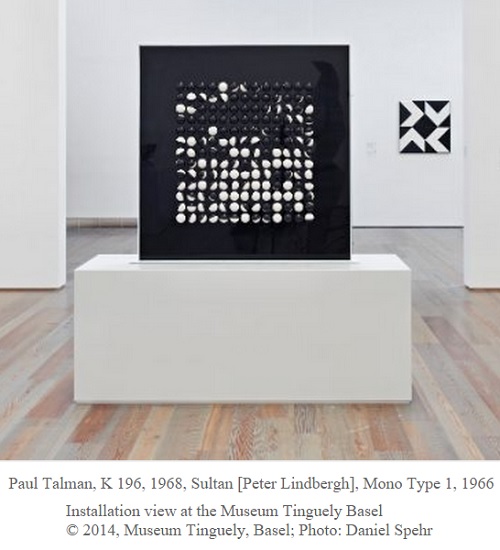
For a connection between the above work by Paul Talman and the
above "Mono Type 1" of Lindbergh, see…
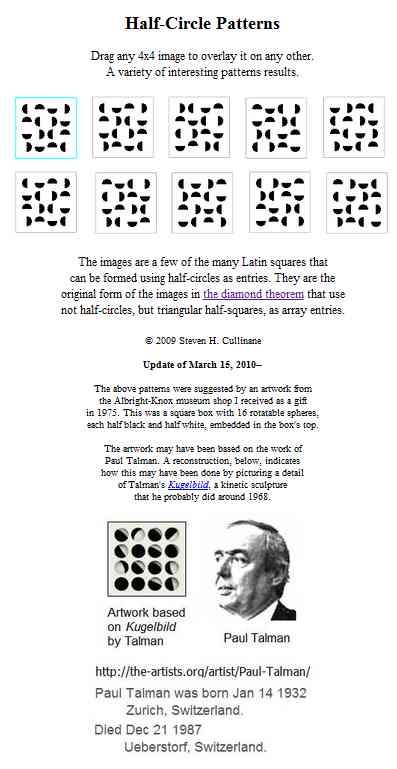
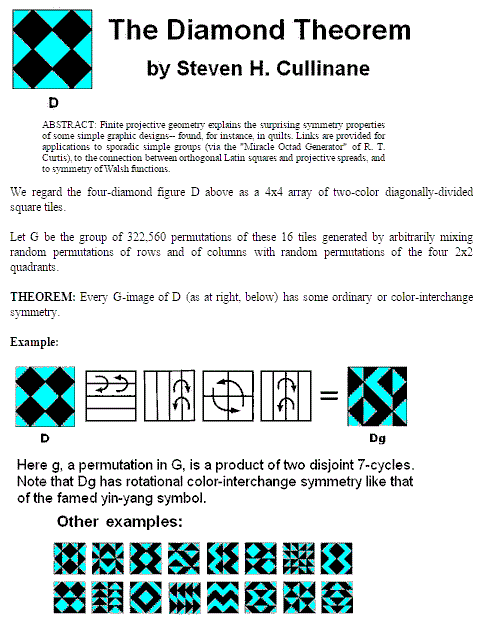
Comments Off on The Lindbergh Manifesto
Monday, November 24, 2014
Comments Off on Metaphysician in the Dark
Friday, November 21, 2014
“When Three Into One Equals More” — New York Times headline

See also Trinity in this journal. From that search:
… The actor is
A metaphysician in the dark….
— Wallace Stevens,
“Of Modern Poetry“
Comments Off on More
Saturday, October 4, 2014
"In ancient Greece, 9 was the number of
the Muses, patron goddesses of the arts.
They were the daughters of Mnemosyne ('memory'),
the source of imagination, which in turn is
the carrier of archetypal, elementary ideas to
artistic realization in the field of space-time."
— Joseph Campbell in The Inner Reaches of Outer Space
In memoriam:

See also Raiders of the Lost Well and…
The Eliot Omen —

Ground plan for a game of Noughts and Crosses
Comments Off on The Source
Wednesday, September 17, 2014
Tom Hanks as Indiana Langdon in Raiders of the Lost Articulation :
An unarticulated (but colored) cube:

A 2x2x2 articulated cube:

A 4x4x4 articulated cube built from subcubes like
the one viewed by Tom Hanks above:

Solomon’s Cube
Comments Off on Raiders of the Lost Articulation
Monday, September 1, 2014
(Continued)
“A set having three members is a single thing
wholly constituted by its members but distinct from them.
After this, the theological doctrine of the Trinity as
‘three in one’ should be child’s play.”
— Max Black, Caveats and Critiques: Philosophical Essays
in Language, Logic, and Art , Cornell U. Press, 1975

“There is such a thing as a three-set.”
— Saying adapted from a novel by Madeleine L’Engle
Comments Off on Mathematics, Not Theology
Friday, August 29, 2014
A possible answer to the 1923 question of Walter Gropius, “Was ist Raum?“—

See also yesterday’s Source of the Finite and the image search
on the Gropius question in last night’s post.
Comments Off on Raum
Wednesday, August 27, 2014
(Continued from Aug. 19, 2014)
“Christian contemplation is the opposite
of distanced consideration of an image:
as Paul says, it is the metamorphosis of
the beholder into the image he beholds
(2 Cor 3.18), the ‘realisation’ of what the
image expresses (Newman). This is
possible only by giving up one’s own
standards and being assimilated to the
dimensions of the image.”
— Hans Urs von Balthasar,
The Glory of the Lord:
A Theological Aesthetics,
Vol. I: Seeing the Form
[ Schau der Gestalt ],
Ignatius Press, 1982, p. 485
A Bauhaus approach to Schau der Gestalt :

I prefer the I Ching ‘s approach to the laws of cubical space.
Comments Off on Schau der Gestalt
Monday, December 9, 2013
An I Ching study quoted in Waiting for Ogdoad (St. Andrew's Day, 2013)—
(Click for clearer image.)

The author of the above I Ching study calls his lattice "Arising Heaven."
The following lattice might, therefore, be called "Heaven Descending."

Click for the source, mentioned in Anatomy of a Cube (Sept. 18, 2011).
Comments Off on Heaven Descending
Sunday, September 22, 2013
From yesterday —
"… a list of group theoretic invariants
and their geometric incarnation…"
— David Lehavi on the Kummer 166 configuration in 2007
Related material —

"The hint half guessed, the gift half understood, is Incarnation."
— T. S. Eliot in Four Quartets
"This is not theology; this is mathematics."
— Steven H. Cullinane on four quartets
To wit:

Click to enlarge.
Comments Off on Incarnation, Part 2
Saturday, September 21, 2013
Mathematics:
A review of posts from earlier this month —
Wednesday, September 4, 2013
Unexpected connections between areas of mathematics
previously thought to be unrelated are sometimes referred
to as "moonshine." An example— the apparent connections
between parts of complex analysis and groups related to the
large Mathieu group M24. Some recent work on such apparent
connections, by Anne Taormina and Katrin Wendland, among
others (for instance, Miranda C.N. Cheng and John F.R. Duncan),
involves structures related to Kummer surfaces .
In a classic book, Kummer's Quartic Surface (1905),
R.W.H.T. Hudson pictured a set of 140 structures, the 80
Rosenhain tetrads and the 60 Göpel tetrads, as 4-element
subsets of a 16-element 4×4 array. It turns out that these
140 structures are the planes of the finite affine geometry
AG(4,2) of four dimensions over the two-element Galois field.
(See Diamond Theory in 1937.)
Thursday, September 5, 2013
(Continued from yesterday)
The foreword by Wolf Barth in the 1990 Cambridge U. Press
reissue of Hudson's 1905 classic Kummer's Quartic Surface
covers some of the material in yesterday's post Moonshine.
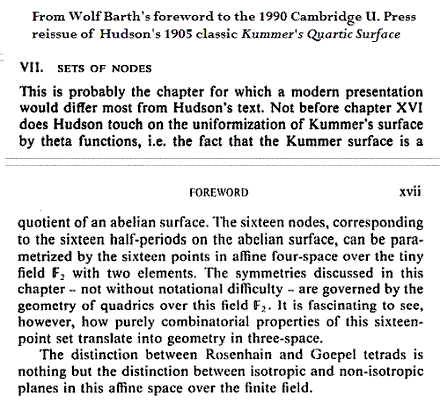
The distinction that Barth described in 1990 was also described, and illustrated,
in my 1986 note "Picturing the smallest projective 3-space." The affine 4-space
over the the finite Galois field GF(2) that Barth describes was earlier described—
within a 4×4 array like that pictured by Hudson in 1905— in a 1979 American
Mathematical Society abstract, "Symmetry invariance in a diamond ring."
"The distinction between Rosenhain and Goepel tetrads
is nothing but the distinction between isotropic and
non-isotropic planes in this affine space over the finite field."
The 1990 paragraph of Barth quoted above may be viewed as a summary
of these facts, and also of my March 17, 2013, note "Rosenhain and Göpel
Tetrads in PG(3,2)."
|
Narrative:

Aooo.
Happy birthday to Stephen King.
Comments Off on Mathematics and Narrative (continued)
Thursday, September 5, 2013
(Continued from yesterday)
The foreword by Wolf Barth in the 1990 Cambridge U. Press
reissue of Hudson's 1905 classic Kummer's Quartic Surface
covers some of the material in yesterday's post Moonshine.

The distinction that Barth described in 1990 was also described, and illustrated,
in my 1986 note "Picturing the smallest projective 3-space." The affine 4-space
over the the finite Galois field GF(2) that Barth describes was earlier described—
within a 4×4 array like that pictured by Hudson in 1905— in a 1979 American
Mathematical Society abstract, "Symmetry invariance in a diamond ring."
"The distinction between Rosenhain and Goepel tetrads
is nothing but the distinction between isotropic and
non-isotropic planes in this affine space over the finite field."
The 1990 paragraph of Barth quoted above may be viewed as a summary
of these facts, and also of my March 17, 2013, note "Rosenhain and Göpel
Tetrads in PG(3,2)."
Comments Off on Moonshine II
Wednesday, September 4, 2013
Unexpected connections between areas of mathematics
previously thought to be unrelated are sometimes referred
to as "moonshine." An example— the apparent connections
between parts of complex analysis and groups related to the
large Mathieu group M24. Some recent work on such apparent
connections, by Anne Taormina and Katrin Wendland, among
others (for instance, Miranda C.N. Cheng and John F.R. Duncan),
involves structures related to Kummer surfaces .
In a classic book, Kummer's Quartic Surface (1905),
R.W.H.T. Hudson pictured a set of 140 structures, the 80
Rosenhain tetrads and the 60 Göpel tetrads, as 4-element
subsets of a 16-element 4×4 array. It turns out that these
140 structures are the planes of the finite affine geometry
AG(4,2) of four dimensions over the two-element Galois field.
(See Diamond Theory in 1937.)
A Google search documents the moonshine
relating Rosenhain's and Göpel's 19th-century work
in complex analysis to M24 via the book of Hudson and
the geometry of the 4×4 square.
Comments Off on Moonshine
Thursday, January 24, 2013
For the late Cardinal Glemp of Poland,
who died yesterday, some links:

Comments Off on Cube Space
Tuesday, October 9, 2012
Last night’s post discussed ways of draining the world of meaning.
For some tastes, poets like Dante do the opposite, supplying too much meaning.
See a New Republic review, dated Oct. 5, in which Harvard atheist Helen Vendler discusses Dante’s
“… assertion that Beatrice herself ‘was this number [nine],’ since nine is the square of three, the number belonging to the Trinity. Dante’s fantastic reasoning requires pages of annotation, which Frisardi, drawing on a number of commentators, furnishes to the bewildered reader. The theological elaboration of the number nine— merely one instance of how far from our own* are Dante’s habits of thought— will convince any doubting reader that the Vita Nuova requires annotation far beyond what its pages might seem to demand.”
Related material— Ninefold in this journal, and remarks by Joseph Campbell in a post, Plan 9, from Sept. 5.
* Speak for yourself, Helen.
Comments Off on Too Much Meaning
Tuesday, June 12, 2012
Background: Geometry of the Dance (May 9)
and Midnight in Oslo (May 10).
Peter Pesic has described the action of the
symmetric group S4 on a tetrahedron as a dance—

Compare and contrast:
The following figure may be seen as a tetrahedron,
viewed from above—
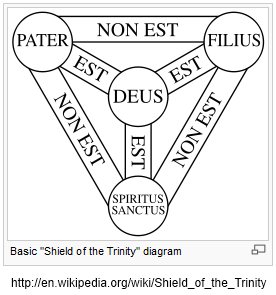
See also Masterman and Child’s Play.
Comments Off on Dance Theology
Sunday, June 3, 2012
(Continued)
“A set having three members is a single thing
wholly constituted by its members but distinct from them.
After this, the theological doctrine of the Trinity as
‘three in one’ should be child’s play.”
– Max Black, Caveats and Critiques: Philosophical Essays
in Language, Logic, and Art , Cornell U. Press, 1975

Related material—
The Trinity Cube

Saturday, February 25, 2012
(Continued. See previous post and Red and Gray in this journal.)
“Give faith a fighting chance.” —Country song
From a post of June 3, 2007—

Related illustration relevant to theology—

For some background, see Cube Trinity in this journal.
For greater depth, see Levering’s Scripture and Metaphysics:
Aquinas and the Renewal of Trinitarian Theology ,
Blackwell, 2004, page 150.
Comments Off on The Rock
Wednesday, January 11, 2012
"Examples galore of this feeling must have arisen in the minds of the people who extended the Magic Cube concept to other polyhedra, other dimensions, other ways of slicing. And once you have made or acquired a new 'cube'… you will want to know how to export a known algorithm , broken up into its fundamental operators , from a familiar cube. What is the essence of each operator? One senses a deep invariant lying somehow 'down underneath' it all, something that one can’t quite verbalize but that one recognizes so clearly and unmistakably in each new example, even though that example might violate some feature one had thought necessary up to that very moment. In fact, sometimes that violation is what makes you sure you’re seeing the same thing , because it reveals slippabilities you hadn’t sensed up till that time….
… example: There is clearly only one sensible 4 × 4 × 4 Magic Cube. It is the answer; it simply has the right spirit ."
— Douglas R. Hofstadter, 1985, Metamagical Themas: Questing for the Essence of Mind and Pattern (Kindle edition, locations 11557-11572)
See also Many Dimensions in this journal and Solomon's Cube.
Comments Off on Cuber
Tuesday, January 10, 2012
"'Interpenetration'" — Stanley Fish in yesterday evening's online New York Times
"You want Frye's with that?" — A recent humanities graduate


Comments Off on Frye’s
(Continued from Epiphany and from yesterday.)
Detail from the current American Mathematical Society homepage—
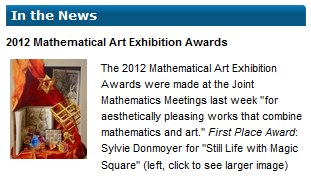
Further detail, with a comparison to Dürer’s magic square—
The three interpenetrating planes in the foreground of Donmoyer‘s picture
provide a clue to the structure of the the magic square array behind them.
Group the 16 elements of Donmoyer’s array into four 4-sets corresponding to the
four rows of Dürer’s square, and apply the 4-color decomposition theorem.
Note the symmetry of the set of 3 line diagrams that result.
Now consider the 4-sets 1-4, 5-8, 9-12, and 13-16, and note that these
occupy the same positions in the Donmoyer square that 4-sets of
like elements occupy in the diamond-puzzle figure below—

Thus the Donmoyer array also enjoys the structural symmetry,
invariant under 322,560 transformations, of the diamond-puzzle figure.
Just as the decomposition theorem’s interpenetrating lines explain the structure
of a 4×4 square , the foreground’s interpenetrating planes explain the structure
of a 2x2x2 cube .
For an application to theology, recall that interpenetration is a technical term
in that field, and see the following post from last year—
Comments Off on Defining Form
Sunday, August 28, 2011
Yesterday's midday post, borrowing a phrase from the theology of Marvel Comics,
offered Rubik's mechanical contrivance as a rather absurd "Cosmic Cube."
A simpler candidate for the "Cube" part of that phrase:

The Eightfold Cube
As noted elsewhere, a simple reflection group* of order 168 acts naturally on this structure.
"Because of their truly fundamental role in mathematics,
even the simplest diagrams concerning finite reflection groups
(or finite mirror systems, or root systems—
the languages are equivalent) have interpretations
of cosmological proportions."
— Alexandre V. Borovik in "Coxeter Theory: The Cognitive Aspects"
Borovik has a such a diagram—

The planes in Borovik's figure are those separating the parts of the eightfold cube above.
In Coxeter theory, these are Euclidean hyperplanes. In the eightfold cube, they represent three of seven projective points that are permuted by the above group of order 168.
In light of Borovik's remarks, the eightfold cube might serve to illustrate the "Cosmic" part of the Marvel Comics phrase.
For some related theological remarks, see Cube Trinity in this journal.
Happy St. Augustine's Day.
* I.e., one generated by reflections : group actions that fix a hyperplane pointwise. In the eightfold cube, viewed as a vector space of 3 dimensions over the 2-element Galois field, these hyperplanes are certain sets of four subcubes.
Comments Off on The Cosmic Part
Saturday, August 27, 2011

Prequel — (Click to enlarge)

Background —

See also Rubik in this journal.
* For the title, see Groups Acting.
Comments Off on Cosmic Cube*
Monday, July 11, 2011
An image that may be viewed as
a cube with a “+“ on each face—

The eightfold cube

Underlying structure
For the Pope and others on St. Benedict’s Day
who prefer narrative to mathematics—
Comments Off on Accentuate the Positive
Saturday, June 25, 2011
Hypostasis (philosophy)
“… the formula ‘Three Hypostases in one Ousia ‘
came to be everywhere accepted as an epitome
of the orthodox doctrine of the Holy Trinity.
This consensus, however, was not achieved
without some confusion….” —Wikipedia

Ousia
Click for further details:

Comments Off on Theology for Antichristmas
Friday, June 10, 2011
Some background for yesterday’s posts:
Midrash for Gnostics and related notes,
as well as yesterday’s New York Lottery.
…. “We seek
The poem of pure reality, untouched
By trope or deviation, straight to the word,
Straight to the transfixing object, to the object
At the exactest point at which it is itself,
Transfixing by being purely what it is….”
— Wallace Stevens (1879-1955),
“An Ordinary Evening in New Haven” IX
“Reality is the beginning not the end,
Naked Alpha, not the hierophant Omega,
of dense investiture, with luminous vassals.”
— Wallace Stevens,
“An Ordinary Evening in New Haven” VI
Wikipedia—
“A hierophant is a person who brings religious congregants into the presence of that which is deemed holy . The word comes from Ancient Greece, where it was constructed from the combination of ta hiera , ‘the holy,’ and phainein , ‘to show.’ In Attica it was the title of the chief priest at the Eleusinian Mysteries. A hierophant is an interpreter of sacred mysteries and arcane principles.”
Weyl as Alpha, Chern as Omega—
(Click to enlarge.)

Postscript for Ellen Page, star of “Smart People”
and of “X-Men: The Last Stand“— a different page 679.
Your assignment, should you choose to accept it—
Interpret today’s NY lottery numbers— Midday 815, Evening 888.
My own bias is toward 815 as 8/15 and 888 as a trinity,
but there may be less obvious and more interesting approaches.
Comments Off on Hierophant
Tuesday, March 30, 2010
Harvard Crimson headline today–
“Deconstructing Design“
Reconstructing Design
The phrase “eightfold way” in today’s
previous entry has a certain
graphic resonance…
For instance, an illustration from the
Wikipedia article “Noble Eightfold Path” —

Adapted detail–

See also, from
St. Joseph’s Day—

Harvard students who view Christian symbols
with fear and loathing may meditate
on the above as a representation of
the Gankyil rather than of the Trinity.
Comments Off on Eightfold Symmetries
Monday, March 2, 2009
Today in History – March 2
By The Associated Press
Today is Monday, March 2, the 61st day of 2009. There are 304 days left in the year.
Today's Highlight in History:
On March 2, 1939, Roman Catholic Cardinal Eugenio Pacelli was elected Pope on his 63rd birthday; he took the name Pius XII.
|

Log24 on June 9, 2008—
From Gravity's Rainbow (Penguin Classics, 1995), page 563:
"He brings out the mandala he found.
'What's it mean?'
[….]
Slothrop gives him the mandala. He hopes it will work like the mantra that Enzian told him once, mba-kayere (I am passed over), mba-kayere… a spell […]. A mezuzah. Safe passage through a bad night…."
In lieu of Slothrop's mandala, here is another…
Related mandalas: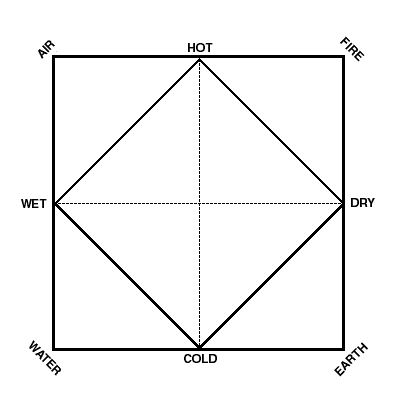
and

For further details,
click on any of the
three mandalas above.
|
Comments Off on Monday March 2, 2009
Thursday, February 5, 2009
Through the
Looking Glass:
A Sort of Eternity
From the new president’s inaugural address:
“… in the words of Scripture, the time has come to set aside childish things.”
The words of Scripture:
| 9 |
For we know in part, and we prophesy in part. |
| 10 |
But when that which is perfect is come, then that which is in part shall be done away. |
| 11 |
When I was a child, I spake as a child, I understood as a child, I thought as a child: but when I became a man, I put away childish things. |
| 12 |
For now we see through a glass, darkly, but then face to face: now I know in part; but then shall I know even as also I am known.
— First Corinthians 13 |
“through a glass”—
[di’ esoptrou].
By means of
a mirror [esoptron].
Childish things:

 © 2005 The Institute for Figuring
© 2005 The Institute for Figuring
Photo by Norman Brosterman
fom the Inventing Kindergarten
exhibit at The Institute for Figuring
(co-founded by Margaret Wertheim)
Not-so-childish:
Three planes through
the center of a cube
that split it into
eight subcubes:

Through a glass, darkly:
A group of 8 transformations is
generated by affine reflections
in the above three planes.
Shown below is a pattern on
the faces of the 2x2x2 cube
that is symmetric under one of
these 8 transformations–
a 180-degree rotation:

(Click on image
for further details.)
But then face to face:
A larger group of 1344,
rather than 8, transformations
of the 2x2x2 cube
is generated by a different
sort of affine reflections– not
in the infinite Euclidean 3-space
over the field of real numbers,
but rather in the finite Galois
3-space over the 2-element field.

Galois age fifteen,
drawn by a classmate.
These transformations
in the Galois space with
finitely many points
produce a set of 168 patterns
like the one above.
For each such pattern,
at least one nontrivial
transformation in the group of 8
described above is a symmetry
in the Euclidean space with
infinitely many points.
For some generalizations,
see Galois Geometry.
Related material:
The central aim of Western religion–
"Each of us has something to offer the Creator...
the bridging of
masculine and feminine,
life and death.
It's redemption.... nothing else matters."
-- Martha Cooley in The Archivist (1998)
The central aim of Western philosophy–
Dualities of Pythagoras
as reconstructed by Aristotle:
Limited Unlimited
Odd Even
Male Female
Light Dark
Straight Curved
... and so on ....
“Of these dualities, the first is the most important; all the others may be seen as different aspects of this fundamental dichotomy. To establish a rational and consistent relationship between the limited [man, etc.] and the unlimited [the cosmos, etc.] is… the central aim of all Western philosophy.”
— Jamie James in The Music of the Spheres (1993)
“In the garden of Adding
live Even and Odd…
And the song of love’s recision
is the music of the spheres.”
— The Midrash Jazz Quartet in City of God, by E. L. Doctorow (2000)
A quotation today at art critic Carol Kino’s website, slightly expanded:
“Art inherited from the old religion
the power of consecrating things
and endowing them with
a sort of eternity;
museums are our temples,
and the objects displayed in them
are beyond history.”
— Octavio Paz,”Seeing and Using: Art and Craftsmanship,” in Convergences: Essays on Art and Literature (New York: Harcourt Brace Jovanovich 1987), 52
From Brian O’Doherty’s 1976 Artforum essays– not on museums, but rather on gallery space:
“Inside the White Cube“
“We have now reached
a point where we see
not the art but the space first….
An image comes to mind
of a white, ideal space
that, more than any single picture,
may be the archetypal image
of 20th-century art.”

“Space: what you
damn well have to see.”
— James Joyce, Ulysses
|
Comments Off on Thursday February 5, 2009
Monday, November 24, 2008
Frame Tale

Click on image for details.
Comments Off on Monday November 24, 2008
Sunday, August 3, 2008
Kindergarten
Geometry
Preview of a Tom Stoppard play presented at Town Hall in Manhattan on March 14, 2008 (Pi Day and Einstein's birthday):
The play's title, "Every Good Boy Deserves Favour," is a mnemonic for the notes of the treble clef EGBDF.
The place, Town Hall, West 43rd Street. The time, 8 p.m., Friday, March 14. One single performance only, to the tinkle– or the clang?– of a triangle. Echoing perhaps the clang-clack of Warsaw Pact tanks muscling into Prague in August 1968.
The “u” in favour is the British way, the Stoppard way, "EGBDF" being "a Play for Actors and Orchestra" by Tom Stoppard (words) and André Previn (music).
And what a play!– as luminescent as always where Stoppard is concerned. The music component of the one-nighter at Town Hall– a showcase for the Boston University College of Fine Arts– is by a 47-piece live orchestra, the significant instrument being, well, a triangle.
When, in 1974, André Previn, then principal conductor of the London Symphony, invited Stoppard "to write something which had the need of a live full-time orchestra onstage," the 36-year-old playwright jumped at the chance.
One hitch: Stoppard at the time knew "very little about 'serious' music… My qualifications for writing about an orchestra," he says in his introduction to the 1978 Grove Press edition of "EGBDF," "amounted to a spell as a triangle player in a kindergarten percussion band."
— Jerry Tallmer in The Villager, March 12-18, 2008
Review of the same play as presented at Chautauqua Institution on July 24, 2008:
"Stoppard's modus operandi– to teasingly introduce numerous clever tidbits designed to challenge the audience."
— Jane Vranish, Pittsburgh Post-Gazette, Saturday, August 2, 2008
"The leader of the band is tired
And his eyes are growing old
But his blood runs through
My instrument
And his song is in my soul."
— Dan Fogelberg
"He's watching us all the time."
— Lucia Joyce
Finnegans Wake,
Book II, Episode 2, pp. 296-297:
I'll make you to see figuratleavely the whome of your eternal geomater. And if you flung her headdress on her from under her highlows you'd wheeze whyse Salmonson set his seel on a hexengown.1 Hissss!, Arrah, go on! Fin for fun!
1 The chape of Doña Speranza of the Nacion.
|
Reciprocity
From my entry of Sept. 1, 2003:
"…the principle of taking and giving, of learning and teaching, of listening and storytelling, in a word: of reciprocity….
… E. M. Forster famously advised his readers, 'Only connect.' 'Reciprocity' would be Michael Kruger's succinct philosophy, with all that the word implies."
— William Boyd, review of Himmelfarb, a novel by Michael Kruger, in The New York Times Book Review, October 30, 1994
Last year's entry on this date:
The picture above is of the complete graph K6 … Six points with an edge connecting every pair of points… Fifteen edges in all.
Diamond theory describes how the 15 two-element subsets of a six-element set (represented by edges in the picture above) may be arranged as 15 of the 16 parts of a 4×4 array, and how such an array relates to group-theoretic concepts, including Sylvester's synthematic totals as they relate to constructions of the Mathieu group M24.
If diamond theory illustrates any general philosophical principle, it is probably the interplay of opposites…. "Reciprocity" in the sense of Lao Tzu. See
Reciprocity and Reversal in Lao Tzu.
For a sense of "reciprocity" more closely related to Michael Kruger's alleged philosophy, see the Confucian concept of Shu (Analects 15:23 or 24) described in
Shu: Reciprocity.
Kruger's novel is in part about a Jew: the quintessential Jewish symbol, the star of David, embedded in the K6 graph above, expresses the reciprocity of male and female, as my May 2003 archives illustrate. The star of David also appears as part of a graphic design for cubes that illustrate the concepts of diamond theory:

Click on the design for details.
Those who prefer a Jewish approach to physics can find the star of David, in the form of K6, applied to the sixteen 4×4 Dirac matrices, in
A Graphical Representation
of the Dirac Algebra.
The star of David also appears, if only as a heuristic arrangement, in a note that shows generating partitions of the affine group on 64 points arranged in two opposing triplets.

Having thus, as the New York Times advises, paid tribute to a Jewish symbol, we may note, in closing, a much more sophisticated and subtle concept of reciprocity due to Euler, Legendre, and Gauss. See
The Jewel of Arithmetic and
|
FinnegansWiki:
Salmonson set his seel:
"Finn MacCool ate the Salmon of Knowledge."
Wikipedia:
"George Salmon spent his boyhood in Cork City, Ireland. His father was a linen merchant. He graduated from Trinity College Dublin at the age of 19 with exceptionally high honours in mathematics. In 1841 at age 21 he was appointed to a position in the mathematics department at Trinity College Dublin. In 1845 he was appointed concurrently to a position in the theology department at Trinity College Dublin, having been confirmed in that year as an Anglican priest."
Comments Off on Sunday August 3, 2008
Wednesday, June 11, 2008
Comments Off on Wednesday June 11, 2008
Sunday, April 13, 2008
The Echo
in Plato’s Cave
“It is said that the students of medieval Paris came to blows in the streets over the question of universals. The stakes are high, for at issue is our whole conception of our ability to describe the world truly or falsely, and the objectivity of any opinions we frame to ourselves. It is arguable that this is always the deepest, most profound problem of philosophy.”
— Simon Blackburn, Think (Oxford, 1999)
Michael Harris, mathematician at the University of Paris:
“… three ‘parts’ of tragedy identified by Aristotle that transpose to fiction of all types– plot (mythos), character (ethos), and ‘thought’ (dianoia)….”
— paper (pdf) to appear in Mathematics and Narrative, A. Doxiadis and B. Mazur, eds.
Mythos —
A visitor from France this morning viewed the entry of Jan. 23, 2006: “In Defense of Hilbert (On His Birthday).” That entry concerns a remark of Michael Harris.
A check of Harris’s website reveals a new article:
“Do Androids Prove Theorems in Their Sleep?” (slighly longer version of article to appear in Mathematics and Narrative, A. Doxiadis and B. Mazur, eds.) (pdf).
From that article:
“The word ‘key’ functions here to structure the reading of the article, to draw the reader’s attention initially to the element of the proof the author considers most important. Compare E.M. Forster in Aspects of the Novel:
[plot is] something which is measured not be minutes or hours, but by intensity, so that when we look at our past it does not stretch back evenly but piles up into a few notable pinnacles.”
Ethos —
“Forster took pains to widen and deepen the enigmatic character of his novel, to make it a puzzle insoluble within its own terms, or without. Early drafts of A Passage to India reveal a number of false starts. Forster repeatedly revised drafts of chapters thirteen through sixteen, which comprise the crux of the novel, the visit to the Marabar Caves. When he began writing the novel, his intention was to make the cave scene central and significant, but he did not yet know how:
When I began a A Passage to India, I knew something important happened in the Malabar (sic) Caves, and that it would have a central place in the novel– but I didn’t know what it would be… The Malabar Caves represented an area in which concentration can take place. They were to engender an event like an egg.”
— E. M. Forster: A Passage to India, by Betty Jay
Dianoia —
Flagrant Triviality
or Resplendent Trinity?
“Despite the flagrant triviality of the proof… this result is the key point in the paper.”
— Michael Harris, op. cit., quoting a mathematical paper
Online Etymology Dictionary:
flagrant c.1500, “resplendent,” from L. flagrantem (nom. flagrans) “burning,” prp. of flagrare “to burn,” from L. root *flag-, corresponding to PIE *bhleg– (cf. Gk. phlegein “to burn, scorch,” O.E. blæc “black”). Sense of “glaringly offensive” first recorded 1706, probably from common legalese phrase in flagrante delicto “red-handed,” lit. “with the crime still blazing.”
A related use of “resplendent”– applied to a Trinity, not a triviality– appears in the Liturgy of Malabar:
— The Liturgies of SS. Mark, James, Clement, Chrysostom, and Basil, and the Church of Malabar, by the Rev. J.M. Neale and the Rev. R.F. Littledale, reprinted by Gorgias Press, 2002
On Universals and
A Passage to India:
“”The universe, then, is less intimation than cipher: a mask rather than a revelation in the romantic sense. Does love meet with love? Do we receive but what we give? The answer is surely a paradox, the paradox that there are Platonic universals beyond, but that the glass is too dark to see them. Is there a light beyond the glass, or is it a mirror only to the self? The Platonic cave is even darker than Plato made it, for it introduces the echo, and so leaves us back in the world of men, which does not carry total meaning, is just a story of events.”
Comments Off on Sunday April 13, 2008
Wednesday, October 24, 2007
Descartes’s Twelfth Step
An earlier entry today (“Hollywood Midrash continued“) on a father and son suggests we might look for an appropriate holy ghost. In that context…
Descartes
A search for further background on Emmanuel Levinas, a favorite philosopher of the late R. B. Kitaj (previous two entries), led (somewhat indirectly) to the following figures of Descartes:
This trinity of figures is taken from Descartes’
Rule Twelve in
Rules for the Direction of the Mind. It seems to be meant to suggest an analogy between superposition of colors and superposition of shapes.Note that the first figure is made up of vertical lines, the second of vertical and horizontal lines, and the third of vertical, horizontal, and diagonal lines.
Leon R. Kass recently suggested that the Descartes figures might be replaced by a more modern concept– colors as wavelengths. (
Commentary, April 2007). This in turn suggests an analogy to Fourier series decomposition of a waveform in harmonic analysis. See the Kass essay for
a discussion of the Descartes figures in the context of (pdf)
Science, Religion, and the Human Future (not to be confused with
Life, the Universe, and Everything).
Compare and contrast:
The harmonic-analysis analogy suggests a review of an earlier entry’s
link today to 4/30– Structure and Logic— as well as
re-examination of Symmetry and a Trinity

(Dec. 4, 2002).
See also —
A Four-Color Theorem,
The Diamond Theorem, and
The Most Violent Poem,

from Mike Nichols’s birthday, 2003.
Comments Off on Wednesday October 24, 2007
Sunday, October 14, 2007
The Dipolar God

|
"Logos and logic, crystal hypothesis,
Incipit and a form to speak the word
And every latent double in the word…."
— Wallace Stevens,
"Notes Toward a Supreme Fiction"
|
Yesterday's meditation ("Simon's Shema") on the interpenetration of opposites continues:
Part I: The Jewel in the Lotus
"The fundamental conception of Tantric Buddhist metaphysics, namely, yuganaddha, signifies the coincidence of opposites. It is symbolized by the conjugal embrace (maithuna or kama-kala) of a god and goddess or a Buddha and his consort (signifying karuna and sunyata or upaya and prajna, respectively), also commonly depicted in Tantric Buddhist iconography as the union of vajra (diamond sceptre) and padme (lotus flower). Thus, yuganaddha essentially means the interpenetration of opposites or dipolar fusion, and is a fundamental restatement of Hua-yen theoretic structures."
— p. 148 in "Part II: A Whiteheadian Process Critique of Hua-yen Buddhism," in Process Metaphysics and Hua-Yen Buddhism: A Critical Study of Cumulative Penetration vs. Interpenetration (SUNY Series in Systematic Philosophy), by Steve Odin, State University of New York Press, 1982
Part II: The Dipolar God
And on p. 163 of Odin, op. cit., in "Part III: Theology of the Deep Unconscious: A Reconstruction of Process Theology," in the section titled "Whitehead's Dipolar God as the Collective Unconscious"–
"An effort is made to transpose Whitehead's theory of the dipolar God into the terms of the collective unconscious, so that now the dipolar God is to be comprehended not as a transcendent deity, but the deepest dimension and highest potentiality of one's own psyche."
Part III: Piled High and Deep
Odin obtained his Ph.D. degree from the Department of Philosophy at the State University of New York (SUNY) at Stony Brook in 1980. (See curriculum vitae (pdf).)
For an academic review of Odin's book, see David Applebaum, Philosophy East and West, Vol. 34 (1984), pp. 107-108.
It is perhaps worth noting, in light of the final footnote of Mark D. Brimblecombe's Ph.D. thesis "Dipolarity and God" quoted yesterday, that "tantra" is said to mean "loom." For some less-academic background on the Tantric iconography Odin describes, see the webpage "Love and Passion in Tantric Buddhist Art." For a fiction combining love and passion with the word "loom" in a religious context, see Clive Barker's Weaveworld. This fiction– which is, if not "supreme" in the Wallace Stevens sense, at least entertaining– may correspond to some aspects of the deep Jungian psychological reality discussed by Odin.
Actors portraying
Arendt and Heidegger
Click on image for details.
Comments Off on Sunday October 14, 2007
Saturday, October 13, 2007
Simon’s Shema
“When times are mysterious
Serious numbers will always be heard
And after all is said and done
And the numbers all come home
The four rolls into three
The three turns into two
And the two becomes a
One”
— Paul Simon, 1983 |
Related material:
Simon’s theology here, though radically reductive, is at least consistent with traditional Jewish thought. It may help counteract the thoughtless drift to the left of academic writing in recent decades. Another weapon against leftist nonsense appears, surprisingly, on the op-ed page of
today’s New York Times:
“There is a Communist jargon recognizable after a single sentence. Few people in Europe have not joked in their time about ‘concrete steps,’ ‘contradictions,’ ‘the interpenetration of opposites,’ and the rest.”
— Doris Lessing, winner of this year’s Nobel Prize in Literature
The Times offers Lessing’s essay to counter Harold Bloom’s remark that this year’s award of a Nobel Prize to Lessing is “pure political correctness.” The following may serve as a further antidote to Bloom.
The Communist use of “interpenetration,” a term long used to describe the Holy Trinity, suggests– along with Simon’s hymn to the Unity, and the rhetorical advice of Norman Mailer quoted here yesterday— a search for the full phrase “interpenetration of opposites” in the context* of theology. Such a search yields a rhetorical gem from New Zealand:
* See the final footnote on the final page (249) of Brimblecombe’s thesis:
3 The Latin word contexo means to interweave, join, or braid together.
A check of the Online Eymology Dictionary supports this assertion:
- context 1432, from L. contextus “a joining together,” orig. pp. of contexere “to weave together,” from com– “together” + textere “to weave” (see texture).
See also Wittgenstein on “theology as grammar” and “context-sensitive” grammars as (unlike Simon’s reductive process) “noncontracting”– Log24, April 16, 2007: Happy Birthday, Benedict XVI.
Comments Off on Saturday October 13, 2007
Monday, July 23, 2007
Daniel Radcliffe
is 18 today.
Greetings.
“The greatest sorcerer (writes Novalis memorably)
would be the one who bewitched himself to the point of
taking his own phantasmagorias for autonomous apparitions.
Would not this be true of us?”
–Jorge Luis Borges, “Avatars of the Tortoise”
“El mayor hechicero (escribe memorablemente Novalis)
sería el que se hechizara hasta el punto de
tomar sus propias fantasmagorías por apariciones autónomas.
¿No sería este nuestro caso?”
–Jorge Luis Borges, “Los Avatares de la Tortuga“
Autonomous Apparition
At Midsummer Noon:
“In Many Dimensions (1931)
Williams sets before his reader the
mysterious Stone of King Solomon,
an image he probably drew from
a brief description in Waite’s
The Holy Kabbalah (1929) of
a supernatural cubic stone
on which was inscribed
‘the Divine Name.’”
Related material:
|
It is not enough to cover the rock with leaves.
We must be cured of it by a cure of the ground
Or a cure of ourselves, that is equal to a cure
Of the ground, a cure beyond forgetfulness.
And yet the leaves, if they broke into bud,
If they broke into bloom, if they bore fruit,
And if we ate the incipient colorings
Of their fresh culls might be a cure of the ground.
– Wallace Stevens, “The Rock”
|
See also
“… I realized that to me,
Gödel and Escher and Bach
were only shadows
cast in different directions by
some central solid essence.
I tried to reconstruct
the central object, and
came up with this book.”
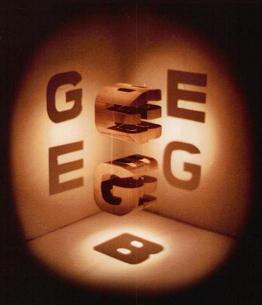 Hofstadter’s cover.
Hofstadter’s cover.
Here are three patterns,
“shadows” of a sort,
derived from a different
“central object”:
Click on image for details.
Comments Off on Monday July 23, 2007
Thursday, July 12, 2007
On Interpenetration,
or Coinherence, of Souls
The August 2007 issue of Notices of the American Mathematical Society contains a review of a new book by Douglas Hofstadter, I Am a Strange Loop. (2007, Basic Books, New York. $26.95, 412 pages.)
A better review, in the Los Angeles Times of March 18, 2007, notes an important phrase in the book, "interpenetration of souls," that the AMS Notices review ignores.
Here is an Amazon.com search on "interpenetration" in the Hofstadter book:
|
1.
|
on Page 217:
|
|
"… described does not create a profound blurring of two people's identities. Tennis and driving do not give rise to deep interpenetrations of souls. …"
|
|
2.
|
on Page 237:
|
|
"… What seems crucial here is the depth of interpenetration of souls the sense of shared goals, which leads to shared identity. Thus, for instance, Carol always had a deep, …"
|
|
3.
|
on Page 270:
|
|
"… including the most private feelings and the most confidential confessions, then the interpenetration of our worlds becomes so great that our worldviews start to fuse. Just as I could jump to California when …"
|
|
4.
|
on Page 274:
|
|
"… we choose to downplay or totally ignore the implications of the everyday manifestations of the interpenetration of souls. Consider how profoundly wrapped up you can become in a close friend's successes and failures, in their very …"
|
|
5.
|
on Page 276:
|
|
"… Interpenetration of National Souls Earlier in this chapter, I briefly offered the image of a self as analogous to a country …"
|
|
6.
|
from Index:
|
|
"… birthday party for, 350 "bachelor", elusiveness of concept, 178 bad-breath analogy, 150 bandwidth of communication as determinant of degree of interpenetration, 212 213, 220, …"
|
|
7.
|
from Index:
|
|
"… phrases denying interpenetration of souls, 270 271; physical phenomena that lack consciousness, 281 282; physical structures lacking hereness, 283; potential personal attributes, 183; …"
|
The American Mathematical Society editors and reviewer seem to share Hofstadter's ignorance of Christian doctrine; they might otherwise have remembered a rather famous remark: "This is not mathematics, it is theology."
For more on the theology of interpenetration, see Log24 on "Perichoresis, or Coinherence" (Jan. 22, 2004).
For a more mathematical approach to this topic, see Spirituality Today, Spring 1991:
"… the most helpful image is perhaps the ellipse often used to surround divine figures in ancient art, a geometrical figure resulting from the overlapping, greater or lesser, of two independent circles, an interpenetration or coinherence which will, in some sense, reunify divided humanity, thus restoring to some imperfect degree the original image of God."
See also the trinitarian doctrine implicit in related Log24 entries of July 1, 2007, which include the following illustration of the geometrical figure described, in a somewhat confused manner, above:
Comments Off on Thursday July 12, 2007
Thursday, May 17, 2007
Logos
for
Yolanda King,
who died May 15,
the birthday of
L. Frank Baum:
Tin Man, Lion, Scarecrow

Symbols of, left to right,
Philip K. Dick (see 3/2/06),
Robert Anton Wilson (see 6/11/03),
and Kurt Vonnegut (see Palm Sunday,
an Autobiographical Collage).
See also An Unholy Trinity (5/6/07).
The "sunrise" logo at top,
along with the three-part motto
"Educate, Empower, Entertain,"
is Yolanda King's own.
Older Posts »














































